第一部分:理论知识学习部分
程序:一段静态的代码,应用程序执行的蓝本。
进程:是程序的一次动态执行,它对应了从代码加载、执行至执行完毕的一个完整过程。
多线程:进程执行过程中产生的多条执行线索,比进程执行更小的单位。
线程不能独立存在,必须存在于进程中,同一进程的各线程间共享进程空间的数据。
每个线程有它自身的产生、存在和消亡的过程, 是一个动态的概念。
多线程意味着一个程序的多行语句可以看上去几 乎在同一时间内同时运行。
线程创建、销毁和切换的负荷远小于进程,又称 为轻量级进程

Java实现多线程有两种途径:
‐创建Thread类的子类
‐在程序中定义实现Runnable接口的类
用Thread类的子类创建多线程的关键性操作:
–定义Thread类的子类并实现用户线程操作,即 run()方法的实现。
–在适当的时候启动线程。
由于Java只支持单重继承,用这种方法定义的类不 可再继承其他父类。
二、实验部分
1、实验目的与要求
(1) 掌握线程概念;
(2) 掌握线程创建的两种技术;
(3) 理解和掌握线程的优先级属性及调度方法;
(4) 掌握线程同步的概念及实现技术;
2、实验内容和步骤
实验1:测试程序并进行代码注释。
测试程序1:
l 在elipse IDE中调试运行ThreadTest,结合程序运行结果理解程序;
l 掌握线程概念;
l 掌握用Thread的扩展类实现线程的方法;
l 利用Runnable接口改造程序,掌握用Runnable接口创建线程的方法。
| class Lefthand extends Thread { public void run() { for(int i=0;i<=5;i++) { System.out.println("You are Students!"); try{ sleep(500); } catch(InterruptedException e) { System.out.println("Lefthand error.");} } } } class Righthand extends Thread { public void run() { for(int i=0;i<=5;i++) { System.out.println("I am a Teacher!"); try{ sleep(300); } catch(InterruptedException e) { System.out.println("Righthand error.");} } } } public class ThreadTest { static Lefthand left; static Righthand right; public static void main(String[] args) { left=new Lefthand(); right=new Righthand(); left.start(); right.start(); } } |
Runnable接口改造的程序:
class Lefthand extends Thread { public void run() { for(int i=0;i<=5;i++) { System.out.println("You are Students!"); try{ sleep(500); }//在指定的毫秒数内让当前正在执行的线程休眠(暂停执行 catch(InterruptedException e) //当线程在活动之前或活动期间处于正在等待、休眠或占用状态且该线程被中断时,抛出该异常。有时候,一种方法可能希望测试当前线程是否已被中断,如果已被中断,则立即抛出此异常。 { System.out.println("Lefthand error.");} } } } class Righthand extends Thread { public void run() { for(int i=0;i<=5;i++) { System.out.println("I am a Teacher!"); try{ sleep(300); } catch(InterruptedException e) { System.out.println("Righthand error.");} } } } public class ThreadTest { static Lefthand left; static Righthand right; public static void main(String[] args) { Runnable left1 = new Lefthand(); Runnable right1 = new Righthand() ; Thread left = new Thread(left1); Thread right = new Thread(right1); left.start();//使该线程开始执行;Java 虚拟机调用该线程的 run 方法。 right.start(); } }
运行结果均为:
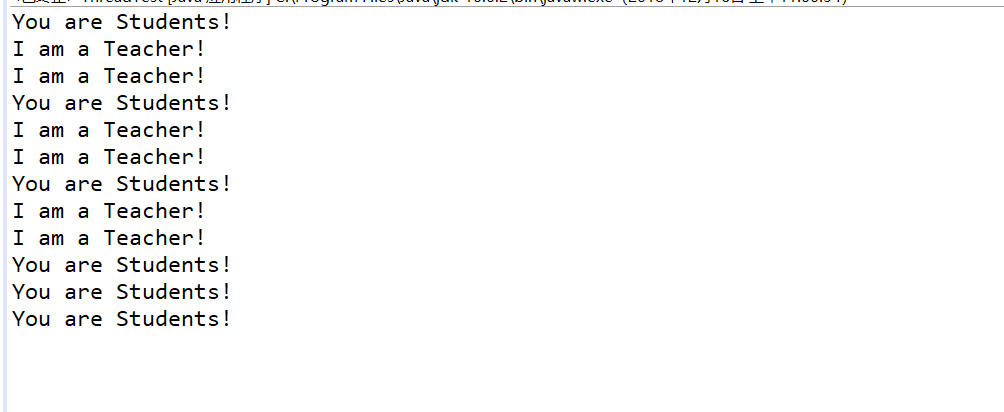
测试程序2:
l 在Elipse环境下调试教材625页程序14-1、14-2 、14-3,结合程序运行结果理解程序;
l 在Elipse环境下调试教材631页程序14-4,结合程序运行结果理解程序;
l 对比两个程序,理解线程的概念和用途;
l 掌握线程创建的两种技术。
package bounce; import java.awt.*; import java.awt.event.*; import javax.swing.*; /** * Shows an animated bouncing ball. * @version 1.34 2015-06-21 * @author Cay Horstmann */ public class Bounce { public static void main(String[] args) { EventQueue.invokeLater(() -> { JFrame frame = new BounceFrame(); frame.setDefaultCloseOperation(JFrame.EXIT_ON_CLOSE); frame.setVisible(true); }); } } Bounce
package bounce; import java.awt.*; import java.util.*; import javax.swing.*; /** * The component that draws the balls. * @version 1.34 2012-01-26 * @author Cay Horstmann */ public class BallComponent extends JPanel { private static final int DEFAULT_WIDTH = 450; private static final int DEFAULT_HEIGHT = 350; private java.util.List<Ball> balls = new ArrayList<>(); /** * Add a ball to the component. * @param b the ball to add */ public void add(Ball b) { balls.add(b); } public void paintComponent(Graphics g) { super.paintComponent(g); // erase background Graphics2D g2 = (Graphics2D) g; for (Ball b : balls) { g2.fill(b.getShape()); } } public Dimension getPreferredSize() { return new Dimension(DEFAULT_WIDTH, DEFAULT_HEIGHT); } }
package bounce; import java.awt.geom.*; /** * A ball that moves and bounces off the edges of a rectangle * @version 1.33 2007-05-17 * @author Cay Horstmann */ public class Ball { private static final int XSIZE = 15; private static final int YSIZE = 15; private double x = 0; private double y = 0; private double dx = 1; private double dy = 1; /** * Moves the ball to the next position, reversing direction if it hits one of the edges */ public void move(Rectangle2D bounds) { x += dx; y += dy; if (x < bounds.getMinX()) { x = bounds.getMinX(); dx = -dx; } if (x + XSIZE >= bounds.getMaxX()) { x = bounds.getMaxX() - XSIZE; dx = -dx; } if (y < bounds.getMinY()) { y = bounds.getMinY(); dy = -dy; } if (y + YSIZE >= bounds.getMaxY()) { y = bounds.getMaxY() - YSIZE; dy = -dy; } } /** * Gets the shape of the ball at its current position. */ public Ellipse2D getShape() { return new Ellipse2D.Double(x, y, XSIZE, YSIZE); } }
运行结果: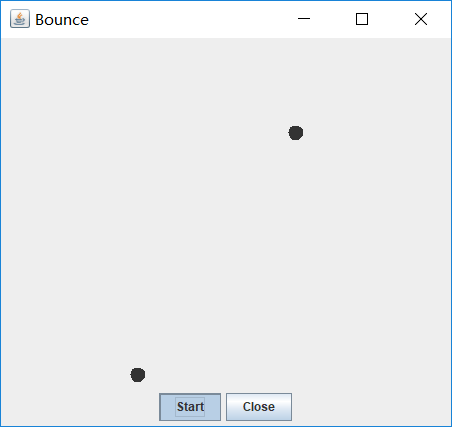
测试程序3:
分析以下程序运行结果并理解程序。
| class Race extends Thread { public static void main(String args[]) { Race[] runner=new Race[4]; for(int i=0;i<4;i++) runner[i]=new Race( ); for(int i=0;i<4;i++) runner[i].start( ); runner[1].setPriority(MIN_PRIORITY); runner[3].setPriority(MAX_PRIORITY);} public void run( ) { for(int i=0; i<1000000; i++); System.out.println(getName()+"线程的优先级是"+getPriority()+"已计算完毕!"); } } |
运行结果:

测试程序4
l 教材642页程序模拟一个有若干账户的银行,随机地生成在这些账户之间转移钱款的交易。每一个账户有一个线程。在每一笔交易中,会从线程所服务的账户中随机转移一定数目的钱款到另一个随机账户。
l 在Elipse环境下调试教材642页程序14-5、14-6,结合程序运行结果理解程序;
package synch; /** * This program shows how multiple threads can safely access a data structure. * @version 1.31 2015-06-21 * @author Cay Horstmann */ public class SynchBankTest { public static final int NACCOUNTS = 100; public static final double INITIAL_BALANCE = 1000; public static final double MAX_AMOUNT = 1000; public static final int DELAY = 10; public static void main(String[] args) { Bank bank = new Bank(NACCOUNTS, INITIAL_BALANCE); for (int i = 0; i < NACCOUNTS; i++) { int fromAccount = i; Runnable r = () -> { try { while (true) { int toAccount = (int) (bank.size() * Math.random()); double amount = MAX_AMOUNT * Math.random(); bank.transfer(fromAccount, toAccount, amount); Thread.sleep((int) (DELAY * Math.random())); } } catch (InterruptedException e) { } }; Thread t = new Thread(r); t.start(); } } }
package synch; import java.util.*; import java.util.concurrent.locks.*; /** * A bank with a number of bank accounts that uses locks for serializing access. * @version 1.30 2004-08-01 * @author Cay Horstmann */ public class Bank { private final double[] accounts; private Lock bankLock; private Condition sufficientFunds; /** * Constructs the bank. * @param n the number of accounts * @param initialBalance the initial balance for each account */ public Bank(int n, double initialBalance) { accounts = new double[n]; Arrays.fill(accounts, initialBalance); bankLock = new ReentrantLock(); sufficientFunds = bankLock.newCondition(); } /** * Transfers money from one account to another. * @param from the account to transfer from * @param to the account to transfer to * @param amount the amount to transfer */ public void transfer(int from, int to, double amount) throws InterruptedException { bankLock.lock(); try { while (accounts[from] < amount) sufficientFunds.await(); System.out.print(Thread.currentThread()); accounts[from] -= amount; System.out.printf(" %10.2f from %d to %d", amount, from, to); accounts[to] += amount; System.out.printf(" Total Balance: %10.2f%n", getTotalBalance()); sufficientFunds.signalAll(); } finally { bankLock.unlock(); } } /** * Gets the sum of all account balances. * @return the total balance */ public double getTotalBalance() { bankLock.lock(); try { double sum = 0; for (double a : accounts) sum += a; return sum; } finally { bankLock.unlock(); } } /** * Gets the number of accounts in the bank. * @return the number of accounts */ public int size() { return accounts.length; } }
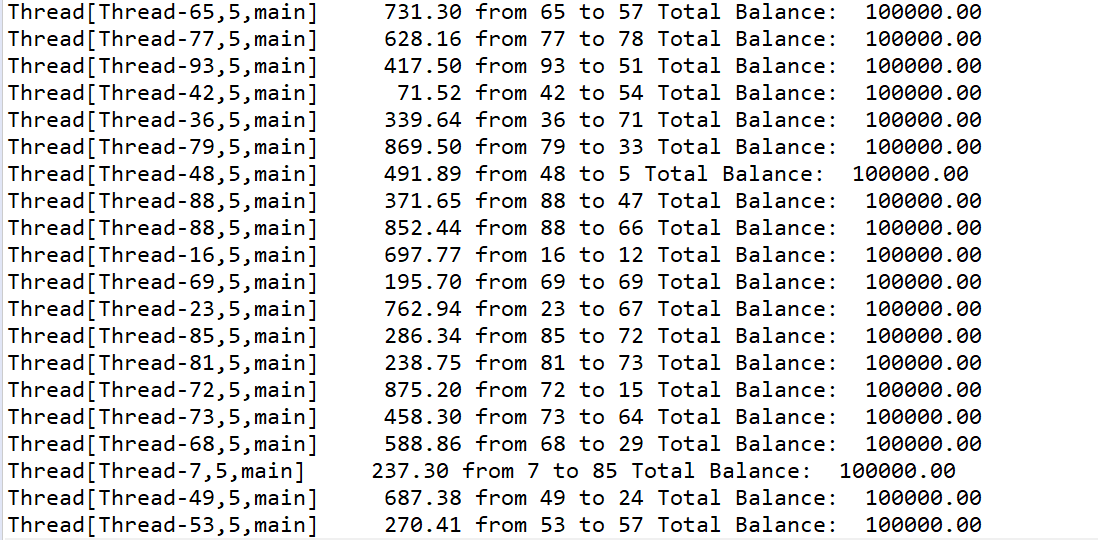
综合编程练习
编程练习1
- 设计一个用户信息采集程序,要求如下:
(1) 用户信息输入界面如下图所示:
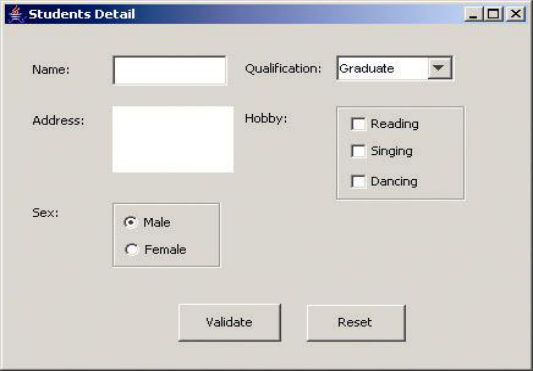
(2) 用户点击提交按钮时,用户输入信息显示控制台界面;
(3) 用户点击重置按钮后,清空用户已输入信息;
(4) 点击窗口关闭,程序退出。
package demo; import java.awt.*; import javax.swing.*; public class Test { public static void main(String[] args) { EventQueue.invokeLater(() -> { Frame frame = new Frame(); frame.setTitle("Student Detail"); frame.setDefaultCloseOperation(JFrame.EXIT_ON_CLOSE); frame.setVisible(true); frame.setResizable(false); }); } }
package demo; import java.awt.*; import javax.swing.*; import java.awt.event.*; public class Frame extends JFrame { private JPanel panel; private JPanel panel1; private JPanel panel2; private JPanel buttonPanel; private JComboBox<String> faceCombo; private JCheckBox Reading; private JCheckBox Singing; private JCheckBox Dancing; private JPanel panelDanXuan; private ButtonGroup option; private JRadioButton optionA; private JRadioButton optionB; private static final int DEFAULT_WITH = 800; private static final int DEFAULT_HEIGHT = 400; public Frame() { //框架a panel = new JPanel(); panel.setPreferredSize(new Dimension(200,160)); panel.setLayout(new GridLayout(2,4)); JLabel lab = new JLabel("Name:", JLabel.CENTER); final JTextField jt = new JTextField(); JLabel lab1 = new JLabel("Qualification:", JLabel.CENTER); faceCombo = new JComboBox<>(); faceCombo.addItem("Graduate"); faceCombo.addItem("Not graduated"); JLabel lab2 = new JLabel("Adress:", JLabel.CENTER); final JTextArea jt1 = new JTextArea(); JLabel lab3 = new JLabel("Hobby:", JLabel.CENTER); panel1 = new JPanel(); Reading = new JCheckBox("Reading"); Singing = new JCheckBox("Singing"); Dancing = new JCheckBox("Dancing "); //框架b panel2 = new JPanel(); panel2.setPreferredSize(new Dimension(200,160)); JLabel lab4 = new JLabel("Sex:", JLabel.CENTER); panelDanXuan = new JPanel(); option = new ButtonGroup(); optionA = new JRadioButton("Male"); optionB = new JRadioButton("Female"); //框架c buttonPanel = new JPanel(); buttonPanel.setPreferredSize(new Dimension(200,80)); JButton jButton1 = new JButton("Validate"); JButton jButton2 = new JButton("Reset"); panel.add(lab); panel.add(jt); panel.add(lab1); panel.add(faceCombo); panel.add(lab2); panel.add(jt1); panel.add(lab3); panel1.add(Reading); panel1.add(Singing); panel1.add(Dancing); panel1.setBorder(BorderFactory.createTitledBorder("")); panel1.setLayout(new BoxLayout(panel1, BoxLayout.Y_AXIS)); panel.add(panel1); panel2.add(lab4); option.add(optionA); option.add(optionB); panelDanXuan.add(optionA); panelDanXuan.add(optionB); panelDanXuan.setBorder(BorderFactory.createTitledBorder("")); panelDanXuan.setLayout(new BoxLayout(panelDanXuan, BoxLayout.Y_AXIS)); panel2.add(panelDanXuan); buttonPanel.add(jButton1); buttonPanel.add(jButton2); add(panel, BorderLayout.NORTH); add(panel2, BorderLayout.WEST); add(buttonPanel, BorderLayout.SOUTH); setSize(DEFAULT_WITH, DEFAULT_HEIGHT); jButton1.addActionListener(new ActionListener() { public void actionPerformed(ActionEvent e) { String Name = jt.getText(); if (Name != null) { System.out.println("Name:"+Name); } String m = faceCombo.getSelectedItem().toString(); System.out.println("Qualification:"+m); String Adress = jt1.getText(); if (Adress != null) { System.out.println("Adress:"+Adress); } System.out.println("Hobby:"); if(Reading.isSelected()) { System.out.println(Reading.getText()); } if(Singing.isSelected()) { System.out.println(Singing.getText()); } if(Dancing.isSelected()) { System.out.println(Dancing.getText()); } System.out.println("Sex:"); if(optionA.isSelected()) { System.out.println(optionA.getText()); } if(optionB.isSelected()) { System.out.println(optionB.getText()); } } }); jButton2.addActionListener(new ActionListener() { public void actionPerformed(ActionEvent e) { jt.setText(""); jt1.setText(""); faceCombo.setSelectedItem("Graduate"); Reading.setSelected(false); Singing.setSelected(false); Dancing.setSelected(false); option.clearSelection(); } }); } }

2.创建两个线程,每个线程按顺序输出5次“你好”,每个“你好”要标明来自哪个线程及其顺序号。
package demo; class Lefthand extends Thread { public void run() { for (int i = 1; i <= 5; i++) { System.out.println(i+":a.你好!"); try { sleep(300); } catch (InterruptedException e) { System.out.println("Lefthand error."); } } } } class Righthand extends Thread { public void run() { for (int i = 1; i <= 5; i++) { System.out.println(i+":b.你好!"); try { sleep(300); } catch (InterruptedException e) { System.out.println("Righthand error."); } } } } public class ThreadTest { static Lefthand left; static Righthand right; public static void main(String[] args) { left = new Lefthand(); right = new Righthand(); left.start(); right.start(); } }
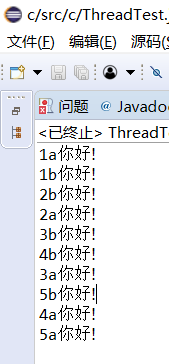
3. 完善实验十五 GUI综合编程练习程序。
实验总结:通过这周的学习知道了什么是线程、 掌握了线程创建的两种技术,实现Runnable接口。理解和掌握线程的优先级属性及调度方法,但没有完全掌握。